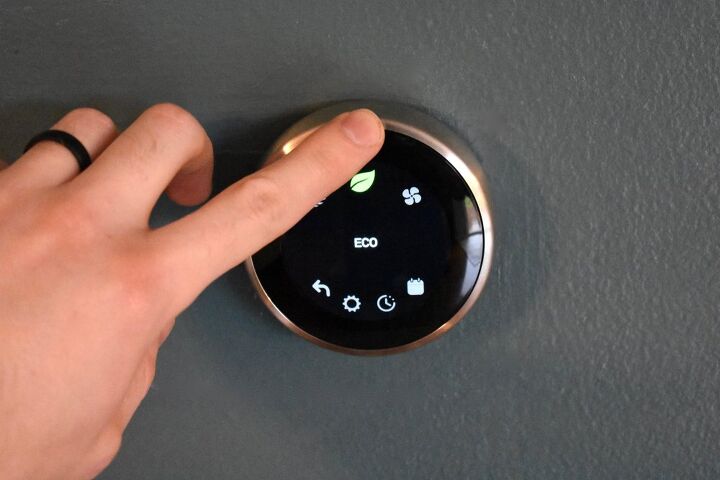Nest Thermostat Battery Keeps Draining? (We Have a Fix!)

Having a Google Nest thermostat can help you live comfortably and conveniently from season to season. However, as is the case with most technology, you’re likely to run into technical issues along the way. One of these issues involves the battery inside your thermostat.
If your Nest thermostat battery is continuously losing power or draining faster than usual, check to see if it is connected to your HVAC system through a C-wire, look for any blown fuses or frayed wires, or manually charge the battery back to full. If the problem persists, get in touch with an electrician or Google Nest support team member.
Before we can talk a bit more about why your Nest thermostat battery is draining, it’s important to know how the batteries work in the first place. Let’s take a closer look.
Do You Need Your Thermostat Repaired or Reprogrammed?
Get free, zero-commitment quotes from pro contractors near you.

How Do Nest Batteries Work?
The Nest thermostat uses a rechargeable lithium-ion battery that keeps the system connected to your Wi-Fi network. However, Wi-Fi connectivity can be extremely draining on the battery and will drain it rather quickly if the battery is powering the thermostat on its own.
For that reason, your Nest thermostat will charge itself through your HVAC system’s wiring. If your system has a C-wire you should always expect a solid connection. The main problem with your Nest battery will occur when your system does not have a C-wire.
What is a C-Wire?
A C-wire, or common wire, provides direct power to your Wi-Fi-enabled thermostat by directly connecting it to your heating and cooling system. It provides a continuous supply of 24-volt power.
Most thermostats are required to have a C-wire, but some battery-powered systems do not necessarily need one. That said, it may be a good idea to have it anyway.
How to Know if Your Thermostat has a C-Wire
First, turn off the power for your furnace through the breaker box or switch. Doublecheck that the power is off and remove the thermostat from the wall plate. However, don’t remove any wires. From there, the process is easy. Simply check if there is a wire in the C-Terminal.
How Your Thermostat is Powered without a C-Wire
If your Nest thermostat does not have a C-wire, it will recharge its battery through your HVAC system as the heating or cooling runs. It does this by diverting some of the system’s power to the battery. If you run your heating and air conditioning on a regular basis, this won’t end up being much of a problem.
It only really becomes an issue if you live in a more mild climate that doesn’t require you to run the heat or air conditioning all the time. When your system is not running, your Nest will attempt to draw power from the HVAC system when it is off.
This drawing of power is supposed to be an undetected “pulse” that isn’t meant to disrupt your system. That said, many HVAC systems are very sensitive and will take this power pulse as a signal to turn on. Once the system is on, Nest will stop trying to draw power to charge.
And once it stops trying to draw power, the system will turn off again. Since the thermostat’s battery will still be low, it will try to do this again, and the cycle will continue. The result is your HVAC system will rapidly turn on and off in a loop.
How to Solve Common Problems with Your Nest Battery
If you are continuously experiencing issues with your Nest thermostat’s battery, there are a few different things that can be going wrong. Luckily, most issues are fairly easy to fix.
Add a C-Wire
We’ve spent a great deal of this article talking about C-wires, so you should have a better understanding of them by now. Therefore, it shouldn’t be any surprise that a main fix to your battery draining issue has to do with getting one.
Google Nest claims that you do not need a C-wire to operate your thermostat. While this is technically true, it is still the cause of many battery issues. In fact, Nest even tells consumers to try using your thermostat without a C-wire and then add it if you end up experiencing problems without it.
Should you end up needing a C-wire, there are a couple of things you can do. First, you may already have a C-wire hidden in the wall that can be used with your thermostat. If you do not, it means you may need an adapter to add a 5th wire to an existing 4-wire setup.
Check for Wiring Issues
Improper wiring to your HVAC system can affect its access to the power supply, which will in turn cause the battery to start draining. Before you install your Nest thermostat, you should have done a compatibility checker to make sure your HVAC system will work with the thermostat.
In addition to checking any problems with C-wire connections (or lack thereof), you should also look at the fuses on the system’s control board. Any blown fuses can prevent power from reaching the Nest thermostat, which will drain the battery over time.
Fully Charge the Built-In Battery
If your battery is drained below a certain voltage and doesn’t get charged above it over time, it can take a toll on the battery life over time. Be sure to charge the battery to full to avoid this issue.
Even if your Nest thermostat is not in use, the battery will still drain over time. Once the battery gets too low, your thermostat will become unstable and begin to malfunction.
If the thermostat is not charging through your HVAC system, you can also use a charging port to manually charge it. When your Nest thermostat is charging, you will see a blinking red light at the top. It should usually take two to three hours to completely charge.
Connect with a Professional
Whether you feel uncomfortable checking the wiring yourself, or the problem is more complex, it’s never a bad idea to check in with a professional. Google Nest has their own support team, so you can talk to a representative over the phone. You can also get in touch with a local electrician to take a look at your system.
Related Questions
Are RC wires the same as a C-wires?
Common wires and RC wires have similar functions for a thermostat. A C-wire provides a continuous supply of 24-volt power to a thermostat. An RC wire can perform the same function, but it is specifically marked for cooling and paired with an RH wire for heating.
What voltage should my Nest battery be at?
The absolute minimum reading for your Nest battery is 3.6V. It will operate at this voltage, but it isn’t recommended for it to stay there for long periods of time. A more stable operating voltage is about 3.8V.
Can a Nest thermostat work without a Wi-Fi connection?
Yes, you can still use your Nest thermostat without an internet or Wi-Fi connection. However, you will have limited access to smart and remote features. For that reason, you will have to set temperatures and settings from the thermostat itself.
Do You Need Your Thermostat Repaired or Reprogrammed?
Get free, zero-commitment quotes from pro contractors near you.

Conclusion
If your Nest thermostat battery is experiencing issues keeping a charge, there are a handful of fixes you can try to get everything back in working order. First and foremost, check out your C-wire situation. Even if your compatibility test said you didn’t need it, it may be time to get one. You may be dealing with other wiring and charging issues.
Whatever the case, it won’t hurt to try and troubleshoot the issue your own. Then, if you really need an extra hand, you can get in touch with a local professional that can get your thermostat back to its peak condition once more.
Related Guides

I am a copywriter and editor based in the Las Vegas area with nearly a decade of experience under my belt writing landing pages, cost guides, blog posts, newsletters, case studies, and social media content. I have a degree in Strategic Communication and experience working in both the account and creative spheres. My goal is to always be discovering new interests and bettering myself as a writer and editor along the way.
More by Kerry Souder



























